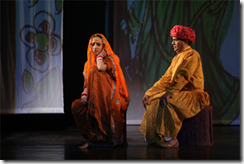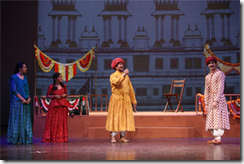Mareechika (Mirage)
Via Delhi-IBSEN festival 2010 :
This play is an adaptation of Henrik Ibsen’s “Lady from the sea” and is directed by Ila Arun.
The story is told in the folk form as the narrative through the balladeers, Bhopa and Bhopi, traditional story-tellers from Rajasthan, who use the Phad, or a painted scroll to tell their stories. The play begins with the Bhopi telling her husband that she had discovered a new phad, called ‘Ibsenji ka phad’, in her late father-in-law’s trunk. She persuades her husband to use this in their next performance, instead of the old, well-worn tales of gods and rajas. He reluctantly agrees and they start their story:
Ibsen’s “The Lady from the Sea” becomes the story of Rampyari, (Ibsen’s Ellida Wangel) so named because she was adopted by a priest devoted to Baba Ramdev, a folk deity of Rajasthan. The priest brings her up as his own daughter. But as she grows up, there is a restlessness about her and a great obsession with water which even she cannot understand. She is drawn towards all water-bodies she can access in a desert land and fantasizes about the ocean and the sea, which she has seen only in her dreams.
One day, a handsome stranger comes to the temple, riding on a horse, just like the hero Baba Ramdev, searching for water for his thirsty horse. She leads him to the ‘bauri’ her favourite haunt, and finds herself fascinated by this stranger (also called Stranger by Ibsen). He tells her of far-off places, of the coast where he comes from, of the sea which he has sailed in a merchant ship. He is also a musician, playing the alogoja. Her fascination takes on a new turn as she is carried away on the wings of fantasy to a world, which has so far existed only in her imagination, the vast and limitless ocean.For her he is her Samander Khan, the spirit of the sea. One day he tells her that he will have to return to his hometown to board his ship. She begs him to take her with him on his horse so that she can catch a glimpse of the ocean which she has always seen in her dreams. Before bidding farewell, they seal their bond by putting their rings on a key ring which they fling far into the ocean, vowing fidelity to each other.
As time passes, she hears that the stranger had drowned in the ocean and she confines herself to a reclusive life, carrying only her obsession with water with her. Then another stranger enters her life, Soubhagmalji Vaidya, (Ibsen’s Dr. Wangel) who comes to the temple to pray for solace after the tragic loss of his wife. He is intrigued by this young girl and hesitantly proposes marriage to her, saying that he needs a companion for himself and a mother for his two young daughters. After her first reaction of shock because of the difference in age, she agrees, her one condition being that he make a home for her near water, since she is like a mermaid that cannot live away from water.
That is a promise he keeps and Rampyari’s love affair with water continues. But fate plays its hand again and the stranger appears, compelling her to leave her husband. After much agonizing, she rejects his suggestion and decides to remain with her husband who has been the perfect husband and protector.But for the Bhopa and Bhopi, there are several unfamiliar references along with unexplained behavioral differences from a different culture. So the story deviates from the original script as the two discuss the strange world of the Wangels, their daughters and the others who stray into their lives. Somewhere in the course of the narrative, the ‘sutradhars’ or storytellers themselves become the characters they play, almost as if the spirit world and the real world had merged into one. But fact is stranger than fiction, they say.
The dazzling display of Rajasthani dance with all it bright colors and costumes , rendered in “Phad” tradition is a treat to watch!.

